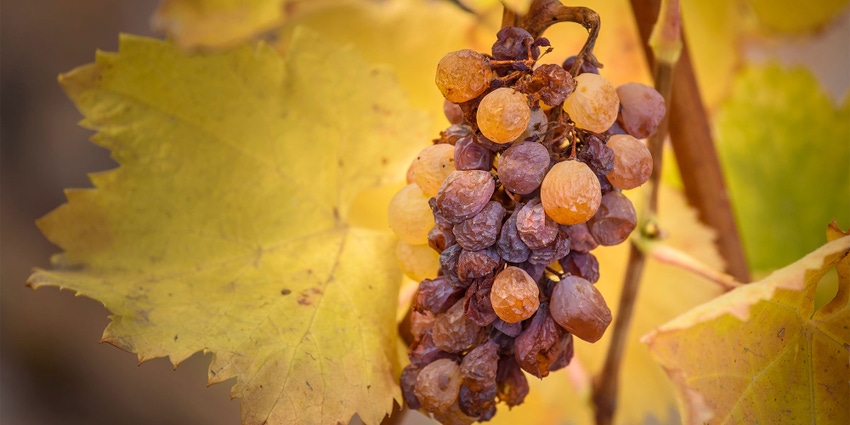September 25, 2019

Sponsored Content
Let’s face it — when it comes to grape growing, there is no off season. What is happening in your vineyard right now will not only affect this year’s harvest but next year’s vines too. UPL has gathered four simple tips to help grape growers finish out the growing season strong and avoid late-season disease threats such as Botrytis bunch rot.
Tip #1: Continue to scout
Grape growers should continue walking through their vineyards scouting for any sign of late disease pressure because there’s a chance infection may still be actively occurring. Late-season Botrytis infections are most severe when relative humidity exceeds 92 percent, free moisture is present on the fruit surface and temperatures are in the 58 to 82 °F range, according to UC IPM. Ripe berries that have experienced damage from insects, birds, hail or machinery are even more susceptible to disease, as the juice in the berry can provide the necessary water and nutrients for fungal growth. This makes September a critical month for scouting.
Tip #2: Take notes
Harvest is a good time for growers to reflect on the season’s disease management program and evaluate the effectiveness of it. Experienced grape growers know when their vineyard encountered disease, the level of severity and what products were applied. Taking notes during this process will help plan for next year’s disease management program.
Tip #3: Switch up modes of action
The mode of action (MOA) you are using can be the difference between a healthy vineyard and a disease outbreak. Alternating modes of action helps prevent pathogen populations from developing resistance to classes of fungicides. It is important to think about the classes of fungicides available when building your resistance management plan for the season. These classes have different MOAs and will each affect the fungus differently. UPL recommends a disease management program that rotates fungicides with different MOAs for the most effective method of fighting resistance.
Tip #4: Act fast
It's no secret how devastating Botrytis bunch rot can be to grape yields. Occurring most commonly near harvest time, it’s important to stop the fungus in its tracks to avoid overwintering. Botrytis cinerea, the causal agent of bunch rot, overwinters as sclerotia, which are hard, durable structures sometimes referred to as "berry mummies." Following rain or irrigation, sclerotia germinate and produce spores that travel via air currents or rain showers. Grape growers use fungicides like PH-D® and ELEVATE® to protect current fruit, minimize the potential future effects of overwintering Botrytis bunch rot and give grapevines a solid foundation leading into the next growing season.
To control Botrytis bunch rot, Group 17 fungicide ELEVATE gives grape growers high-quality protection. With its unique active ingredient, there is no known cross-resistance to other commonly used fungicides. One added benefit of ELEVATE is that it can be used within one day of harvest.
A broad-spectrum Group 19 fungicide, PH-D provides excellent knockdown of powdery mildew and aids in the control of Botrytis bunch rot later in the season. For late-season Botrytis bunch rot control, apply seven days prior to harvest. For powdery mildew, PH-D can be applied up to the day of harvest. PH-D features a 4-hour re-entry interval (REI) and a zero-day PHI.
Don’t stand for late-season disease in your vineyard. With UPL, you can count on dependable disease control and a staff dedicated to keeping your vineyard protected all season long. To learn more about the UPL portfolio of crop protection products, contact your local UPL sales representative or visit www.upl-ltd.com. UPL is the manufacturer of other important grape disease management products including Manzate® Pro-Stick™, Microthiol® Disperss®, Cuprofix® Ultra Disperss, Procure® fungicides.
Always read and follow label directions. All products and the UPL logo are trademarks of UPL Corporation Limited or its related companies. © 2019 UPL NA Inc. SPC-1908N
You May Also Like




